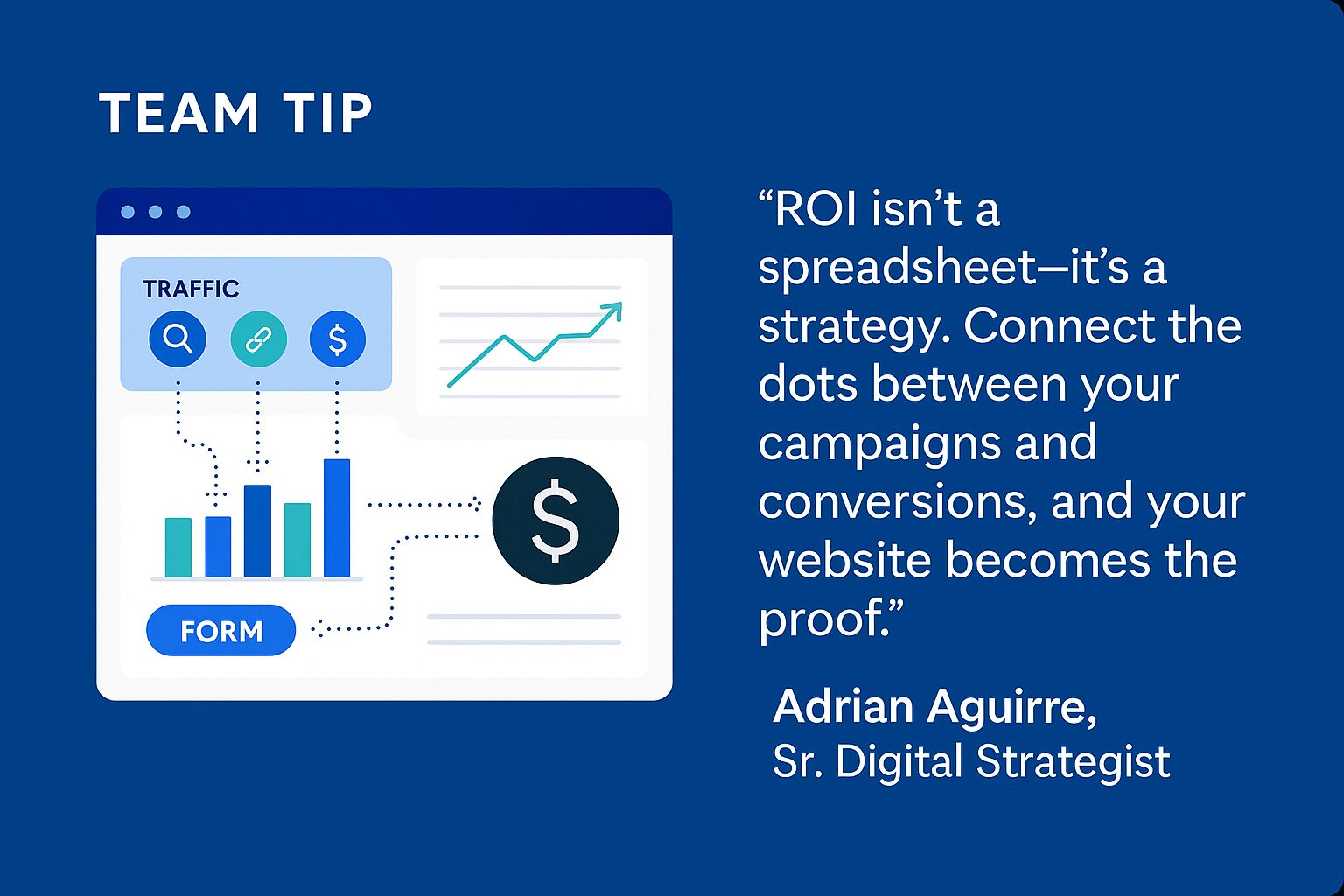-
Lead Generation Should Be Trackable and Tied to Revenue: Use tools like HubSpot or GA4 to attribute form fills, downloads, and demo requests to specific campaigns and channels. Your website should clearly show how it’s generating pipeline, not just traffic.
-
Your Website Must Enable Fast, Campaign-Ready Execution: CMOs value speed and alignment. Build flexible landing pages that match your messaging, can launch quickly, and are easy to test and optimize.
-
Go Beyond Vanity Metrics. Report on Strategic Progress: Highlight growth in organic traffic, form fills, and conversion rates over time. Connect the dots between effort and impact to show compounding marketing value.
-
Support Sales Enablement with Content and Behavior Data: Track how sales-qualified leads use your site: downloads, time on key pages, and responses to nurtures. Your site should be a vital tool for both top- and bottom-of-funnel engagement.
-
Tie Campaign Performance Across Channels to Website Actions: Whether from paid ads, email, webinars, or events, show how each campaign drives traffic, conversions, and sales activity through your website as the hub.
Most marketing managers in B2B manufacturing spend their days building campaigns, managing content, and trying to hit performance goals with limited resources. But despite all that effort, it’s not always easy to prove how your work moves the needle, especially to the CMO.
You’re expected to drive demand, fill the pipeline, and support sales. Yet when quarterly reporting time comes around, the question lingers: What’s the return?
Here’s the good news: your website can be your best tool for demonstrating ROI. When set up strategically, your website becomes more than a digital brochure. It becomes a measurable, lead-generating engine that ties marketing activities directly to business results.
What CMOs Really Want to See
To show value, you need to think like an executive. CMOs are focused on outcomes, not activity. They want to know:
- How marketing contributes to revenue
- Where budget is being spent and whether it’s working
- What’s being tested and optimized
- How marketing supports sales enablement
- Whether the digital experience reflects the brand’s credibility
That means vanity metrics like traffic and impressions don’t cut it. What they care about is impact.

Your Website Is the Bridge Between Marketing and ROI
A well-structured website gives marketing teams the data, flexibility, and tools they need to show results. Here’s how:
1. Trackable Lead Generation
Your website should help you clearly show how many leads are generated by your efforts and what actions drove them.
Make sure you can:
- Attribute leads to specific campaigns and channels
- Identify which landing pages, assets, and CTAs are converting
- Measure form submissions, downloads, and demo requests
- Segment leads by quality or readiness
When set up correctly, tools like HubSpot or Google Analytics paired with form tracking can connect your website activity directly to revenue opportunities.
2. Campaign-Ready Landing Pages
If it takes a week and a dev team just to launch a landing page, you’ll struggle to move fast and miss key moments. Your website should be built for agility.
What CMOs care about here:
- How quickly your team can turn ideas into campaigns
- Whether your pages align with messaging and value props
- The conversion rates of each offer or page
With flexible web design and development and smart templates, marketing teams can launch, test, and iterate without waiting on IT.
3. Performance Metrics That Show Progress
A dashboard that shows traffic is one thing. A dashboard that connects SEO gains, form submissions, and funnel velocity is another.
You’ll want to report on:
- Increases in organic traffic from SEO strategy
- Growth in form submissions over time
- Improvement in bounce rate or engagement on core pages
- Wins from conversion rate optimization
This lets your CMO see that marketing efforts are compounding over time not just producing spikes.
4. Sales Enablement Support
In manufacturing, the website often plays a vital role in the buying process, supporting both early-stage awareness and late-stage sales conversations.
Make it easy to show how your site helps sales by tracking:
- Views and downloads of case studies, spec sheets, and whitepapers
- Page visits from email nurture or outbound campaigns
- Time on site from sales-qualified leads
When sales reps rely on your site to move deals forward, that’s proof of marketing value.
5. Integrated Campaign Performance
Your website isn’t working alone. It’s the central hub that connects your paid media management, email, social, and content efforts.
Track how campaigns perform across:
- Ad traffic to landing pages
- Email clicks to gated offers
- Webinar registrations and follow-up workflows
- Event-specific microsites or CTAs
All of this builds a cohesive ROI narrative around your integrated strategy.
Bonus: What to Avoid When Reporting to the CMO
Skip:
- Fluffy engagement metrics without context
- Overly technical web jargon
- Sharing raw data without recommendations
Instead, focus on:
- Business outcomes (leads, MQLs, influenced revenue)
- Clear insights and trends
- Actions taken based on website learnings
- What’s next: testing, optimizing, improving
The more confident and clear your data story, the more credibility you gain.
How 3 Media Web Can Help
At 3 Media Web, we help manufacturing marketers turn their websites into ROI-driving assets. That means more than uptime and updates: we focus on performance, strategy, and proof.
We support marketing teams by:
- Building sites that support fast, flexible campaigns
- Setting up form tracking, analytics, and dashboards
- Delivering conversion optimization and SEO improvements
- Supporting lead attribution, segmentation, and scoring
- Ensuring every piece of the digital experience aligns with marketing KPIs
With the right support and systems, your website becomes one of your strongest tools to demonstrate the value marketing delivers every quarter.
